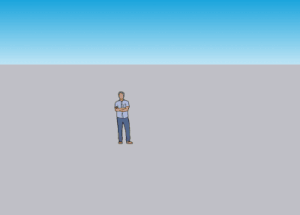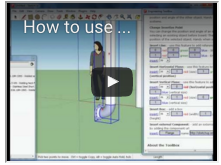Home (original) (raw)
Engineering ToolBox - enabled for use with the older versions of the amazing SketchUp Make and the newer "up to date" SketchUp Pro .
Tools - accessed from within Sketchup
NOTE!! - the insert! and the Tools features only works when the engineeringtoolbox exension is opened from within SketchUp. Install the extension as described in the right column - restart Sketchup and open this tool from the Sketchup Plugins menu.
Edit
undo! redo!
Color
color change color!
Change color of the selected object(s) - may be slow for some more complicated objects (save your model first!)
View
iso! top! front! right! left! back! bottom!
Make Component
make!
Makes a component of the selected object. Note that all objects from the Engineering Toolbox are inserted as individual groups. You should transfer a group to a component sharing the same definition when there is more than one instance of the same object. **Tip!**Rename the object to its final name before making it a component (in outliner or with right click and entity info).
Rotate Object(s)
degrees around red! , green! or blue! axis.
Select object(s) first. This tool may be very handy for objects with curved surfaces like pipes, elbows and so on.
Move or Copy Object(s)
no. copies red offset green offset blue offset unit move/copy!
Move or copy (multiple) selected objects. Make advanced geometric constructions with multiple selections, multiple copies and the offset.Tip! - Use "Make Component" to save space and reduce computer load when working with multiple copies.
Knife
size unit insert the Knife! cut!
Before cut - customize the inserted Knife! The Knife is a group you can rotate, change the size of, and even add or remove objects within (example - add a function curve for an advanced cut). You can also make your own Knife by naming a group "theKnife". After insert and customizing the knife - positioning it to the object(s) where to cut - select the object(s) (must be groups) - and click cut! Afterwards - select the object(s) and remove the parts of the object(s) that you don't want. YouTube demo of the Knife!
Move an Object to an other Objects Position
Select two objects - click "move" - and one of the objects moves to the position and angle of the other object. This tool may be handy when moving objects between axis systems.
Insert (Reference) Line
red green blue startpoint
red green blue endpoint unit insert!
This tool can be used to add reference lines.
Insert Horizontal Plane
red (width) green (depth) blue (vertical position) unit insert!
Insert Vertical Plane
red (horizontal position) green (depth) blue (height) unit insert!
red (width) green (horizontal position) blue (height) unit insert!
Insert Box
red (width) green (depth) blue (height) unit insert!
Engineering ToolBox Sketchup Extension
Insert standard and customized parametric components - like flange beams, lumbers, piping, geometric figures, function curves, stairs and more - to your Google SketchUp models with sketchup.engineeringtoolbox.com

It's FREE and FUN!
Download SketchUp
If you don't have Sketchup installed on your computer - download the older versions of the amazing SketchUp Make or the newer "up to date" SketchUp Pro
Note! - SketchUp Free and Sketchup Shop (the web apps) can't use extensions. You need to install a local version of SketchUp Pro (paid) or Sketchup Make 2017 (free) if you want to use the Engineering ToolBox extension.
Basic Use of the Engineering ToolBox Sketchup Extension
From within Sketchup - open the Engineering ToolBox extension, navigate to component and select insert! - and the component will be added to your model.
Watch basic use of the Engineering ToolBox extension in YouTube
How to add the Engineering ToolBox Extension to your SketchUp
If you experience problems with the functionality - first try to reload the cached page with the link in the top left corner - then try installation with alternative 2 or 3.
Note! The Engineering Toolbox extension in Sketchup Extension Warehouse only works for Sketchup editions up to 2023. For Sketchup edition 2024 and higher the extension can be installed by using installation alternative 2 or 3 below.
Alt. 1 Sketchup Extension Warehouse
- open your Sketchup installation
- from the Sketchup menu - select Window > Extension Warehouse - and search for "Engineering ToolBox" - and install!
- the extension can be enabled/disabled from the Sketchup menu Window > Extension Manager
- restart of Sketchup may be required to activate the extension
Alt. 2 Download the Extension - Install with the Sketchup Extension Manager
- download engineeringtoolbox_tools_v1.0.6.rbz to a location on your computer
- open your Sketchup installation
- from the Sketchup menu - select Window and Extension Manager, the button "Install Extension" - and select the downloaded file
- restart of Sketchup may be required to activate the extension
Alt. 3 Download the Extension - Manual Install
- open the Sketchup Plugin folder on your system
(on Windows it should be something like C:\ProgramData\SketchUp\SketchUp 202X\SketchUp\Plugins\)
(on Mac it should be something like /Users/username/Library/Application Support/SketchUp 20XX/SketchUp/Plugins/) - if present - remove the engineeringtoolbox_tool.rb file and the engineering_tools folder from the Plugin folder
- change the extension for the downloaded file (engineeringtoolbox_tools_v1.0.6.rbz) from rbz to zip
- decompress the file in your file manager
- copy the decompressed engineeringtoolbox_tool.rb file and the engineering_tools folder with its content to the Plugin folder
- restart Sketchup
Note that this procedure may be different in older Sketchup versions.
How to use the Engineering ToolBox Sketchup Extension
From the Sketchup menu - select Extensions > Engineering ToolBox. A page like this opens in a separate window - navigate to the wanted component - and selectinsert! to add the component to your SketchUp model.
Note! The SketchUp Engineering Toolbox is an online resource updated continuously. You need an internet connection to operate.
For some components parameters like length, color, offset and more can be modified before insertion.
Customized components can be inserted by changing parameters in the dialog boxes at the end of the component lists - and clicking "custom!"
Selected objects in the model can be manipulated - rotated, moved, colors changed and more - from the Tools section.
Assistant objects like lines, horizontal and vertical planes can be added.
Some Tips and Tricks
The most efficient way to learn SketchUp is by watching the tutorial videos.
Organize your model in groups - add components to the groups!
Example: Use separate groups for construction steel, piping, the different HVAC systems and more.
Always keep an eye on the model in the "Outliner" window.
Use layers to organize and control the visibility of the model.
The most convenient way to copy an object is by selecting it, using move or (m) and pressing Ctrl (makes a copy) before moving.
Use the rotation tool on this page to precise rotations of components like bends, pipes ...
Precise moving of a object can be done by selecting a point in the object that can be connected to a point in the new position (like a edge on a component, surface, a midpoint or similar).
Bill of Materials
Be aware that objects from The Engineering ToolBox are inserted in Sketchup as Groups. They will show up in the Sketchup > Window > Outliner dialog but not in the Sketchup > Window > Model Info > Statistics (Only Components) dialog.
If you want to make "Bill of Materials" from your model
- insert an object from The Engineering ToolBox
- select the object in the model (or in the Outliner) after insert
- click The Engineering ToolBox "Make Component"
The objects will now show up in the Sketchup > Window > Model Info > Statistics dialog and be available for reporting through Sketchup > File > Generate Report feature or other third party report generators.
An insterted object from The Engineering ToolBox can also be converted to a Component by right clicking the object and selecting Make Component. The name will not be preserved and must be changed after the conversion.
9 19
